苏教版七年级英语下册知识点(2019)
- 格式:doc
- 大小:75.00 KB
- 文档页数:3
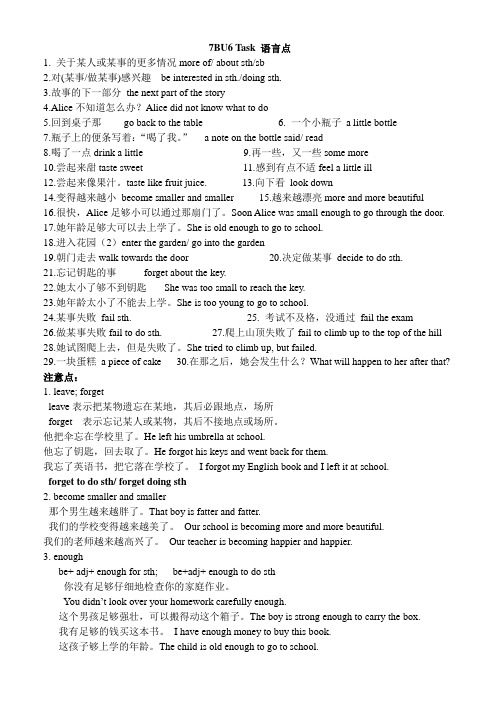
7BU6 Task 语言点1. 关于某人或某事的更多情况more of/ about sth/sb2.对(某事/做某事)感兴趣be interested in sth./doing sth.3.故事的下一部分the next part of the story4.Alice不知道怎么办?Alice did not know what to do5.回到桌子那go back to the table6. 一个小瓶子a little bottle7.瓶子上的便条写着:“喝了我。
” a note on the bottle said/ read8.喝了一点drink a little 9.再一些,又一些some more10.尝起来甜taste sweet 11.感到有点不适feel a little ill12.尝起来像果汁。
taste like fruit juice. 13.向下看look down14.变得越来越小become smaller and smaller 15.越来越漂亮more and more beautiful16.很快,Alice足够小可以通过那扇门了。
Soon Alice was small enough to go through the door.17.她年龄足够大可以去上学了。
She is old enough to go to school.18.进入花园(2)enter the garden/ go into the garden19.朝门走去walk towards the door 20.决定做某事decide to do sth.21.忘记钥匙的事forget about the key.22.她太小了够不到钥匙 She was too small to reach the key.23.她年龄太小了不能去上学。
She is too young to go to school.24.某事失败fail sth. 25. 考试不及格,没通过fail the exam26.做某事失败fail to do sth. 27.爬上山顶失败了fail to climb up to the top of the hill28.她试图爬上去,但是失败了。
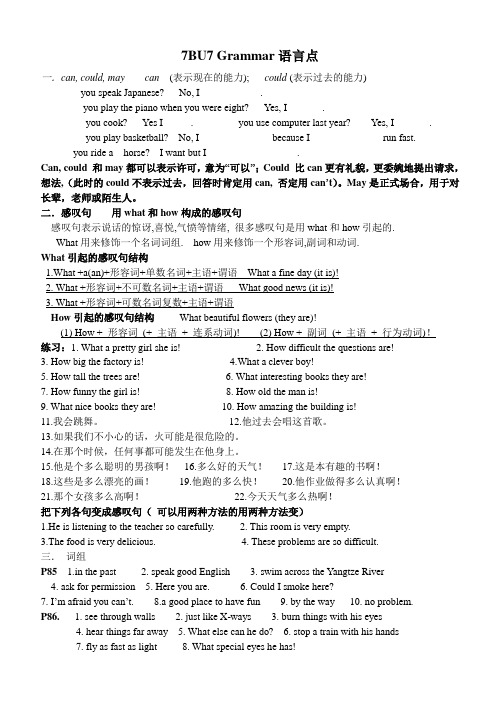
7BU7 Grammar语言点一.can, could, may can (表示现在的能力); could (表示过去的能力)____ you speak Japanese? No, I____________._____you play the piano when you were eight? Yes, I_______._____ you cook? Yes I _____. ______you use computer last year? Yes, I_______._____ you play basketball? No, I ______________because I ______________run fast.___you ride a horse? I want but I__________________.Can, could 和may都可以表示许可,意为“可以”;Could 比can更有礼貌,更委婉地提出请求,想法,(此时的could不表示过去,回答时肯定用can, 否定用can’t)。
May是正式场合,用于对长辈,老师或陌生人。
二.感叹句用what和how构成的感叹句感叹句表示说话的惊讶,喜悦,气愤等情绪, 很多感叹句是用what和how引起的.What用来修饰一个名词词组. how用来修饰一个形容词,副词和动词.What引起的感叹句结构1.What +a(an)+形容词+单数名词+主语+谓语What a fine day (it is)!2. What +形容词+不可数名词+主语+谓语What good news (it is)!3. What +形容词+可数名词复数+主语+谓语How引起的感叹句结构What beautiful flowers (they are)!(1) How + 形容词(+ 主语+ 连系动词)! (2) How + 副词(+ 主语+ 行为动词)!练习:1. What a pretty girl she is! 2. How difficult the questions are!3. How big the factory is!4.What a clever boy!5. How tall the trees are!6. What interesting books they are!7. How funny the girl is! 8. How old the man is!9. What nice books they are! 10. How amazing the building is!11.我会跳舞。
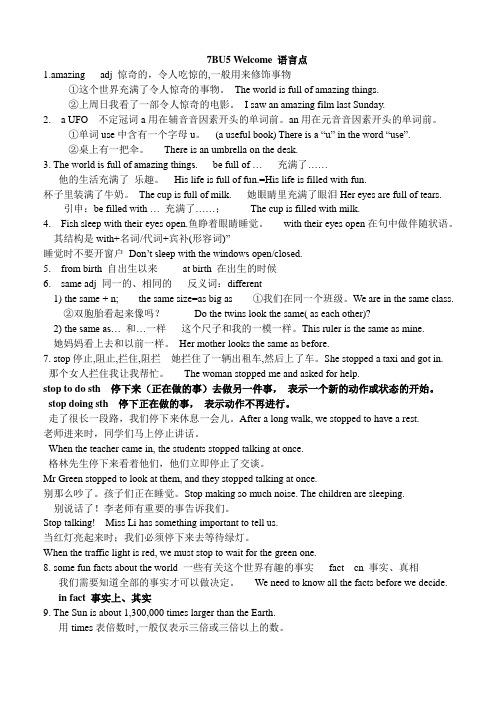
7BU5 Welcome 语言点1.amazing adj 惊奇的,令人吃惊的,一般用来修饰事物①这个世界充满了令人惊奇的事物。
The world is full of amazing things.②上周日我看了一部令人惊奇的电影。
I saw an amazing film last Sunday.2. a UFO 不定冠词a用在辅音音因素开头的单词前。
an用在元音音因素开头的单词前。
①单词use中含有一个字母u。
(a useful book) Th ere is a “u” in the word “use”.②桌上有一把伞。
There is an umbrella on the desk.3. The world is full of amazing things. be full of … 充满了……他的生活充满了乐趣。
His life is full of fun.=His life is filled with fun.杯子里装满了牛奶。
The cup is full of milk. 她眼睛里充满了眼泪Her eyes are full of tears.引申:be filled with … 充满了……;The cup is filled with milk.4. Fish sleep with their eyes open.鱼睁着眼睛睡觉。
with their eyes open在句中做伴随状语。
其结构是with+名词/代词+宾补(形容词)”睡觉时不要开窗户Don’t sleep with the windows open/closed.5. from birth 自出生以来at birth 在出生的时候6. same adj 同一的、相同的反义词:different1) the same + n; the same size=as big as ①我们在同一个班级。
We are in the same class.②双胞胎看起来像吗?Do the twins look the same( as each other)?2) the same as… 和…一样这个尺子和我的一模一样。
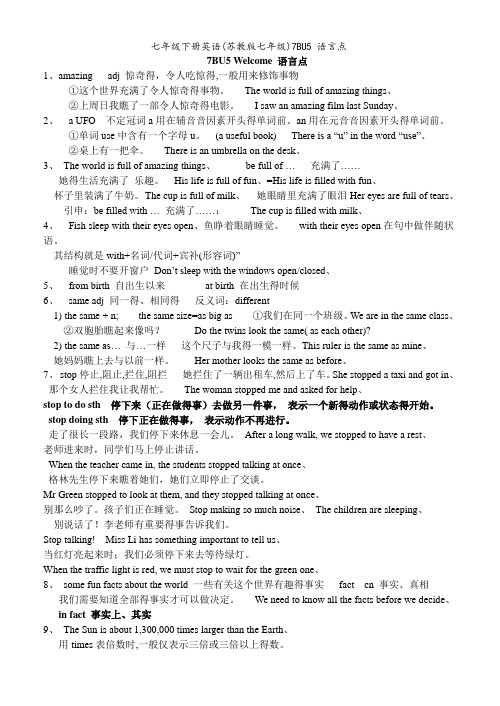
7BU5 Welcome 语言点1、amazing adj 惊奇得,令人吃惊得,一般用来修饰事物①这个世界充满了令人惊奇得事物。
The world is full of amazing things、②上周日我瞧了一部令人惊奇得电影。
I saw an amazing film last Sunday、2、 a UFO 不定冠词a用在辅音音因素开头得单词前。
an用在元音音因素开头得单词前。
①单词use中含有一个字母u。
(a useful book) There is a “u” in the word “use”、②桌上有一把伞。
There is an umbrella on the desk、3、The world is full of amazing things、be full of … 充满了……她得生活充满了乐趣。
His life is full of fun、=His life is filled with fun、杯子里装满了牛奶。
The cup is full of milk、她眼睛里充满了眼泪Her eyes are full of tears、引申:be filled with … 充满了……;The cup is filled with milk、4、Fish sleep with their eyes open、鱼睁着眼睛睡觉。
with their eyes open在句中做伴随状语。
其结构就是with+名词/代词+宾补(形容词)”睡觉时不要开窗户Don’t sleep with the windows o pen/closed、5、from birth 自出生以来at birth 在出生得时候6、same adj 同一得、相同得反义词:different1) the same + n; the same size=as big as ①我们在同一个班级。
We are in the same class、②双胞胎瞧起来像吗?Do the twins look the same( as each other)?2) the same as… 与…一样这个尺子与我得一模一样。

七年级下册u1英语知识点英语作为国际通用语言,是中学教育中必学的语言之一。
在初中阶段,学生的英语掌握程度与将来的发展有着很大的关系。
本文将介绍七年级下册u1英语知识点,帮助学生更好地掌握英语学习。
1. 介绍学习语言首先要掌握语音、语法和词汇,而英语语音有独特之处。
在发音时,要分清元音和辅音的发音方法。
例如,元音的发音嘴巴要张开、舌头放平,辅音的发音则需要咬住舌头或吸入气息。
辅音的分类也有很多种,最常见的有浊音和清音。
此外,语法也是学好英语的关键之一。
对于初学者来说,基本的语法结构和常用句型的掌握非常重要。
例如,肯定句和否定句的构成、疑问词和疑问句的运用都是初中英语语法的核心知识点。
2. 词汇学习词汇是英语学习最基础的部分。
在七年级下册英语中,有很多常用词汇和短语,如介词、代词和连接词等。
而且,初中英语中常常使用词汇的派生形式,如动词的过去式和进行时的变化,以及形容词和副词的比较级和最高级等。
记忆单词的方法有很多,比如通过记忆卡片、单词联想和词根词缀等。
学生需要根据个人的喜好和学习方式选择适合自己的单词记忆方法,以便更好地掌握词汇。
3. 阅读与听力熟练的阅读和听力能力是英语学习的重要组成部分。
七年级下册英语中,阅读理解题和听力理解题占有重要比重。
阅读理解题要求学生通过阅读文章,理解文章传达的意思,并回答问题。
此外,还要学会根据文章的语言风格和场景背景等,推断出文章的含义和作者的态度等。
听力理解题则重点考察学生对英语语音和语法的掌握程度,能否在听力中分辨单词、短语和句子的重音和语气等。
此外,学生还需阅读听力材料的简要说明,理解场景和背景,正确回答问题。
总之,以上三个方面都是初中英语学习至关重要的部分。
学生需要结合实际情况,逐步提高自己的英语水平。
同时,要在学习的过程中,保持兴趣和积极性,不断提高阅读和听力能力,扩大词汇量。
除此之外,学生也可以通过参加交流、讨论等活动等方式,进一步提高自己的英语水平。
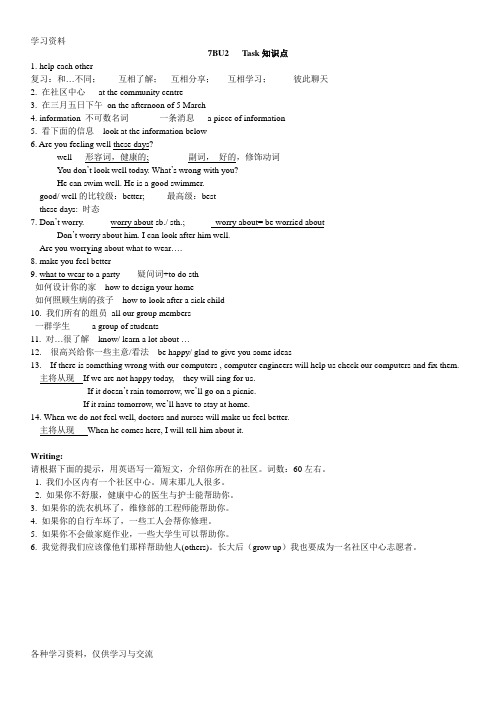
学习资料各种学习资料,仅供学习与交流7BU2 Task知识点1. help each other复习:和…不同;互相了解;互相分享;互相学习;彼此聊天2. 在社区中心at the community centre3. 在三月五日下午on the afternoon of 5 March4. information 不可数名词一条消息 a piece of information5. 看下面的信息look at the information below6. Are you feeling well these days?well 形容词,健康的; 副词,好的,修饰动词You don’t look well today. What’s wrong with you?He can swim well. He is a good swimmer.good/ well的比较级:better; 最高级:bestthese days: 时态7. Don’t worry. worry about sb./ sth.; worry about= be worried aboutDon’t worry about him. I can look after him well.Are you worr y ing about what to wear….8. make you feel better9. what to wear to a party 疑问词+to do sth如何设计你的家how to design your home如何照顾生病的孩子how to look after a sick child10. 我们所有的组员all our group members一群学生 a group of students11. 对…很了解know/ learn a lot about …12. 很高兴给你一些主意/看法be happy/ glad to give you some ideas13. If there is something wrong with our computers , computer engineers will help us check our computers and fix them. 主将从现If we are not happy today, they will sing for us.If it doesn’t rain tomorrow, we’ll go on a picnic.If it rains tomorrow, we’ll have to stay at home.14. When we do not feel well, doctors and nurses will make us feel better.主将从现When he comes here, I will tell him about it.Writing:请根据下面的提示,用英语写一篇短文,介绍你所在的社区。
v1.0可编写可改正
7B Unit 1-5要点词组
1.坐在我旁边13.在七楼
2.在一个小镇上14.世界各地的家
3.想要做某事15.举行聚会
4.二十家饭馆16.在上脚下
5.最大的一个17.待在这儿
6.在第五大街上18.一个大的电视
7.在露台上听音乐19.在我房屋的前方
8.和我弟弟分享蛋糕20.看电影
9.饭馆21.一个家庭影院
10. 享受一杯茶22.足够多的食品
11. 我们自己的寝室23.在底楼
12. 在莫斯科的市中心24.一台洗衣机
13.它位于俄罗斯的国都,莫斯科
14.上海市世界上最大的城市之一
27.你能和你的弟弟共用这台电脑吗
15.我拥有自己的寝室和露台
1
v1.0可编写可改正29.你住在这幢楼的几楼
16.香港是购物的最正确去向。
31.这个商场拥有超出 1000 平方米的面积。
32.公园里各处是鲜花。
2。
7BU2 Integrated知识点1. 一个办公室职员an office worker2. 哥哥/姐姐elder brother/ elder sister3. 两个公司two companies4. 邮局the post office5. 警察局the police station6.在镇中心/在市中心in the town/city centre7. 在他学校附近的警察局工作work in a police station near his school8.上夜班work at night9. 在镇中心的一家饭店上班work in a restaurant in the town centre10. 忙于煮饭be busy (in) cooking11. 骑自行车去上班go to work by bike/ on a bike=ride a bike to work12. 为离她家很远的一家公司工作work for a company far away from her home13. 将来你想做什么?What are you going to be in the future?14. 一个艺术家/画家an artist15. That sounds a good idea. 用于一般现在时Listen! The music sounds very nice. Look! She has a beautiful flower in her hand.16. 病人sick peoplea sick person 不可说成an ill personHe is ill/ sick today. What’s wrong with you?I am feeling sick. 我感觉不舒服。
the sick/ the old/ the young/ the poor 代一类人。
7BU4 Finding the wayWelcome 语言点1. A is +方向 of B (A在B的什么方位)在的东面 Shanghai is of Nanjing. =Shanghai is to the east of Nanjing.A is in the +方向 of B(A在B里面什么方位)在中国的东面 Shanghai is of China. 在中国的东南Taiwan is in the southeast of China.美国在加拿大的南面。
The US is (to the) south of Canada.公园在学校的西北面。
The park is (to the) northwest of the school.在中国的北部。
Beijing is in the north of China. =Beijing is in the northern part of China. 在的北面。
Beijing is (to the) north of Jiangsu.在的北面。
Shandong is (to the)north of Jiangsu.在中国的南部,澳门在的西部。
(Hong Kong, Macau)2. Follow me, Eddie. =Come with me. (follow=come/go after)follow sb. to sp. 请跟我到图书馆。
Please follow me to the library.跟我来,我会告诉你路线。
Follow me and I’ll show you the way.冬去春来。
Spring follows winter. 沿着这条街走到公交车站。
Follow the street to the bus stop.3. Are you sure, Hobo? be sure 确信,有把握(1) be sure to do sth. 表示说话人推测“一定,必然会”。
初一英语时态专题复习一、一般现在时:(1、现在的状态。
2、经常或习惯性动作。
3、主语所具备的性格和能力。
4、真理。
)1、标志:often(经常),usually(通常),sometimes(有时),always(总是),never(从不),on Sundays(在星期天), every day/month/year(每一天/月/年)2、结构:(1)主语+连系动词be(am/is/are)+名词/形容词/数词/介词短语/副词等做表语表状态(包括There be +n.)练习:1.I__am____(be) a student. My name__is___(be) Tom.2. Where __are___(be) my shoes? They_are__(be) here.3.Who _is___(be) the girl with long straight hair? I think she _is__(be) Kate.4. You and I _don’t are__(not be) in Class Six.5._Are__(be) there a supermarket on the Fifth Avenue? Yes, there_are____(be).6. _Do___ her parents tall? No, she__don’t__.(2)主语(非第三人称单数)+行为动词原形+其他(用助动词do 帮助构成否定句、一般疑问句和特殊疑问)(3)主语(第三人称单数)+行为动词的第三人称单数+其他(用助动词does 帮助构成否定句、一般疑问句和特殊疑问句)行为动词第三人称单数加-s的形式1.- s 2. 辅音+y: study-studies 3.以s,x,ch,sh结尾watch-watches teach-teaches4特殊have-has do-does go-goes.1)His parents _______(watch) TV every night. 肯定句1) My brother _________(do) homework every day.2)His parents _________(not watch) every night.否定句2)My brother________(not do)homework every day.3)_____his parents_____(watch) TV every night?一般疑3)______ your brother _____ homework every day?Yes, they _______. No, they _______. Yes, he______. No, he _________.4)When___ his parents _____(watch) TV? 特疑4)When _____ your brother ____(do) homework?They watch TV every night. He does homework every day.二.现在进行时:表示说话瞬间或现阶段正在进行的动作。
苏教版七年级英语下册知识点(2019)
语法
特殊疑问句通常以“what”、“who”、“which”、“when”、“where”、
“how”、“how old”、“how many”等开头,对某一具体问题实行提问。
特殊疑问句的基本构成有两种情况:
1. 疑问句+一般疑问句结构。这是最常见的情况。例如:
What’s your grandfather’s telephone number你爷爷的电话号码是多少
Who is that boy with big eyes那个大眼睛的男孩是谁
Which season do you like best 你最喜欢哪个季节
When is he going to play the piano他什么时候弹钢琴
Where does he live他住在哪儿
》
How are you你好吗 How old are you你多大了
How many brothers and sisters do you have你有几个兄弟姐妹
2. 疑问句+陈述句结构。这时疑问词作主语或修饰主语。例如:
Who is on duty today 今天谁值日
Which man is your teacher 哪位男士是你的老师
我们学过的What/How about+名词/代词+其他也是特殊疑问句,它是一
种省略结构。
例如:
I like English. What/How about you我喜欢英语。你呢
What about playing basketball打篮球怎么样
苏教版英语七年级下册复习重点:词组
#
1. across from …… 在……的对面 across from the bank 在银行的对面
2. next to…… 紧靠…… next to the supermarket 紧靠超市
3. between……and…… 在……和……之间
between the park and the zoo 在公园和动物园之间
among 表示位于三者或三者以上之间
4. in front of…… 在……前面 There is a tree in front of the classroom. 课室前
面有棵树。
in the front of…… 在……(内)的前部 There is a desk in the front of the
classroom.
课室内的前部有张桌子。
5. behind…… 在……后面 behind my house 在我家后面
6. turn left/ right 向左/右拐
:
on the left/right of……在某物的左/右边 on the left of our school 在我们学
校的左边
on one’s left/right 在某人的左/右边 on my left在我左边
7. go straight 一直走
8. down /along……沿着……(街道 down/along Center Street 沿着中央街
9. in the neighborhood=near here 在附近 10 welcome to…… 欢迎来到……
11. take /have a walk 散步 12. the beginning of…… ……的开始,前端
at the beginning of…… 在……的开始,前端 in the beginning 起初,一开始
13. have fun=have a good time=enjoy oneself 玩得开心,过得愉快
我昨天玩得很开心。
I had fun yesterday. I had a good time yesterday. I enjoyed myself
yesterday.
"
14. have a good trip 旅途愉快 15. take a taxi 坐出租车
16. 到达:get to +地方get here/ there/ home 到这/那/家
arrive in +大地方 I arrive in Beijing. arrive at +小地方I arrive at the bank.
reach +地方
across 从物体表面横过 go across the street横过马路
go through 从空间穿过 go through the forest穿过树林
+ 街道的名称。 Eg: on Center Street
at + 具体门牌号+街道的名称 Eg: at 6 Center Street